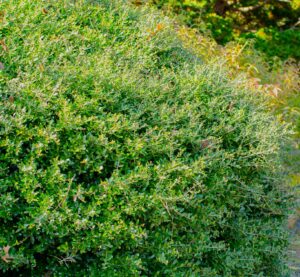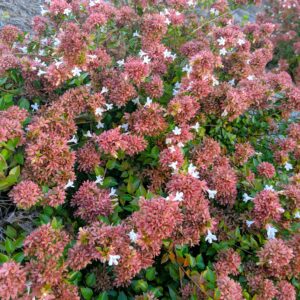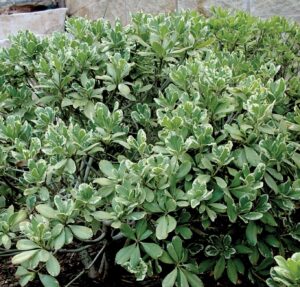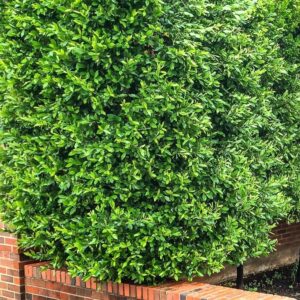Plant This, Not That: Embracing Adapted Shrubs
When it comes to landscaping in North Texas, choosing the right shrubs for the right spot can make all the difference! We’ll admit, our climate and soil conditions can be quite challenging. Sadly, many of the most commonly sold (and planted) landscape shrubs aren’t quite adapted to the region. However, by opting for Texas native, and/or responsibly adapted substitutes, you can create a beautiful, resilient landscape that truly thrives… despite our sometimes-harsh conditions.
The list below digs into better alternatives for common “generic” shrubs which tend to struggle in our environment. Those listed as “Avoid” are those that we suggest replacements for most frequently. As a retail nursery, we have chosen to avoid both selling and recommending those species. We can, however, wholeheartedly recommend the alternative “Plant” suggestions (that we do sell) which can help achieve a similar aesthetic– or garden function!
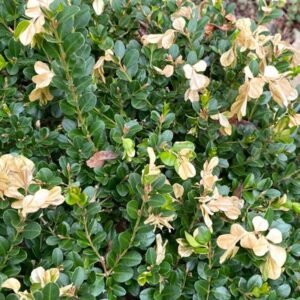
Avoid: Boxwoods
While boxwoods may be a staple in many landscapes, they often struggle in North Texas–due to our hot summers and regular droughts. Throw in a severe freeze, and that’s a 1, 2, 3, punch that can send boxwoods to the (dirt) mat. Instead of battling to keep them alive, consider planting a native alternative that’s better adapted to our climate.
Plant Instead: Dwarf Yaupon Holly (Ilex vomitoria ‘Nana’)
Dwarf yaupon holly is a tough, drought-tolerant shrub that thrives in Texas landscapes. The compact size (3’-4’) of this Texas native cultivar makes it perfect for evergreen hedges or foundation plantings, and it requires minimal maintenance once established. For an even more compact specimen, consider ‘Micron’, a 2’ x 2’ nativar of the same species.
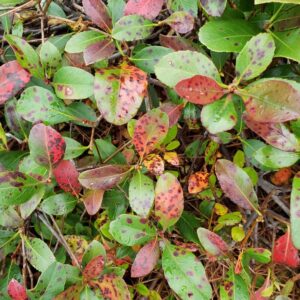
Avoid: Indian Hawthorn
Indian hawthorn is often prized for its delicate flowers and glossy foliage. Over the past three years, in our region at least– they have been dying by the thousands. In addition to the winter freeze damage, and the summer heat waves/drought—it’s becoming more susceptible to insect pests and disease. Our advice: think twice before replanting this poorly adapted shrub.
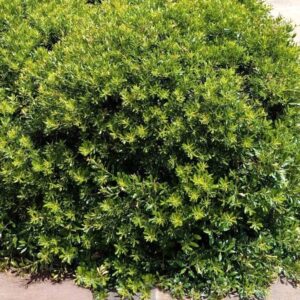
Plant: Dwarf Wax Myrtle (Morella cerifera ‘Don’s Dwarf’)
Dwarf wax myrtle is a native shrub that thrives in North Texas. Its fragrant foliage and compact growth habit make it a versatile choice for foundation plantings, shorter hedges, screens, or even specimen plantings. Plus, it’s super drought-tolerant and attracts pollinators and birds– adding even more value to your landscape!
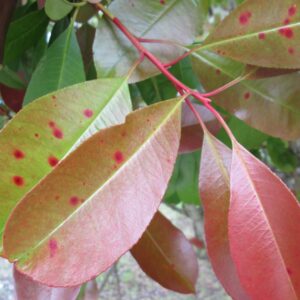
Avoid: Red Tip Photinias
While red tip photinias can be stunning in the right conditions, they commonly struggle with our alkaline soils and extreme temperatures. And unfortunately, the final nail in the coffin for red tip photinias is their susceptiblity to leaf spot diseases, including the Entomosporium fungus that’s slowly wiping them out across the region.
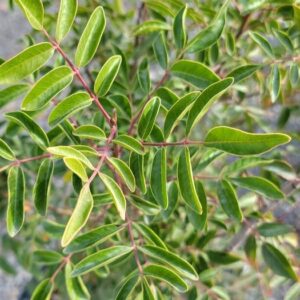
Instead, consider planting: Evergreen sumac (Rhus virens)
This versatile native shrub boasts several features that make it an excellent choice for Texas landscapes. Its dense growth habit and glossy, leaves help create a dense evergreen screen, making it ideal for privacy hedges, windbreaks, or as a backdrop for other plants. Additionally, evergreen sumac produces clusters of small white flowers in the spring, followed by red berries in the fall, which are attractive to wildlife such as native birds and butterflies!
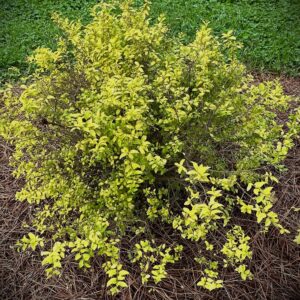
Avoid: ‘Sunshine’ Ligustrum
While ‘Sunshine’ ligustrum’s bright yellow foliage can be eye-catching, this cultivar is sadly not as well-suited to our Texas climate and soils as first reported. The most concerning challenge is that stressed ‘Sunshine’ ligustrums have the propensity to revert back to their green foliage, sending up genetically unique sports. (If you don’t believe us, take a drive on the DNT and head past the Frisco Star.) While, ‘Sunshine’ was touted to be a sterile cultivar, the blooms and seeds that those dark green shoots can produce are somewhat concerning—especially sense they are currently one of the most invasive species in the region. Thats right, ‘Sunshine’ Ligustrum (Ligustrum sinense ‘Sunshine’) is just a rebranding of the dreaded Chinese Privet.
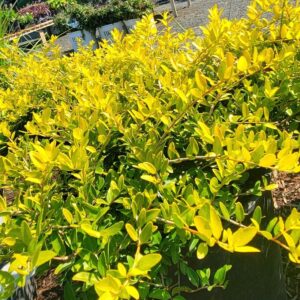
Plant Instead: ‘Eureka Gold’ Yaupon Holly (Ilex vomitoria ‘Eureka Gold’)
This golden-hued variety of a Texas native yaupon holly adds a pop of color to the landscape while offering the same toughness and adaptability as its green counterparts. It’s an excellent choice for adding visual interest to your garden, holding its color best in part sun to part shade areas—and without the maintenance headaches of ligustrums.
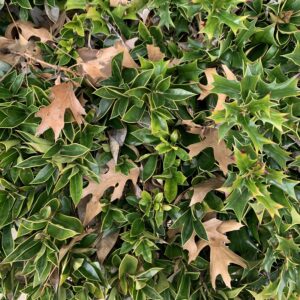
Avoid: ‘Carissa’ Holly
‘Carissa’ holly is a popular choice for builder-grade landscapes (read lower quality) for their evergreen foliage and attractive berries– but new plants often struggle in our alkaline soils and hot, dry summers. Older specimens tend to be short-lived, susceptible to fungal problems in really wet years. It’s unfortunately the plant that we get asked to replace most often.
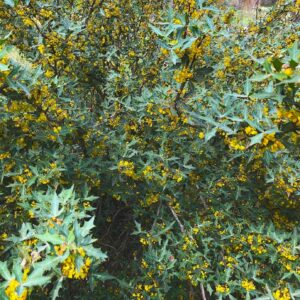
Plant Agarita Instead (Berberis trifoliolata)
A Texas native evergreen, agarita is often a rounded shrub, that is highly ornamental with light pruning. Generally wider than it is tall, it produces beautiful gray-green, holly-like foliage year-round, and clusters of fragrant yellow flowers in spring. The fruit that follows is a bright red berry that is NOT toxic, but rather delicious for humans (in raw form or in jellies), and is a magnet for birds and small mammals!
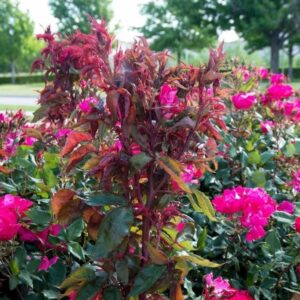
Avoid: Roses
We know this is a controversial statement: While roses can certainly be breathtakingly beautiful, they often require a lot of maintenance and steadfast attention– especially in our challenging climate. And until recently, we felt like that extra attention was truly worth the effort. Then came Rose Rosette Disease (RRD). North Texas is one of epicenters of this viral disease, that’s both spread by a mite which jumps from plant to plant, in addition to being soil borne. Current reports from researchers are promising, and we remain hopeful that certain species and cultivars will be resistant to the virus long term. However, all roses should be carefully watched, with symptomatic (witch-brooming and clusters of prickles) rose specimens removed as soon as possible to avoid the continued spread of this devastating disease. While some dedicated rose-gardeners continue to be successful growing resilient cultivars under a watchful-eye—the vast majority of amateur rosarians are unaware of the disease—as it continues to spread across the state.
For a low-maintenance alternative, consider: ‘Rose Creek’ Abelia (Abelia x grandiflora ‘Rose Creek’)
With its graceful arching evergreen branches and large fragrant rosey-pink flower clusters, ‘Rose Creek’ abelia adds elegance and Texas tough charm to any landscape. Although it’s not a Texas native, it’s extremely drought-tolerant and low-maintenance, as well as pest and disease resistant– making it a perfect choice for busy homeowners looking to enhance their outdoor space without a lot of fuss. It’s also a great pollinator-supporting species as a prefered nectar source for many local pollinators. * for a native alternative look into either the pink or red versions of Texas Rock Rose.
Avoid: Variegated Pittosporum
This is a popular evergreen shrub known for its attractive variegated foliage and dense, rounded growth habit, but to say these plants struggle in North Texas is an understatement. They are very freeze sensitive in our coldest winters, and really don’t care for temperatures above 100 F. They also really prefer well-draining, slightly acidic soils– and North Texas has a lot of alkaline clays. There are just too many challenges to overcome.
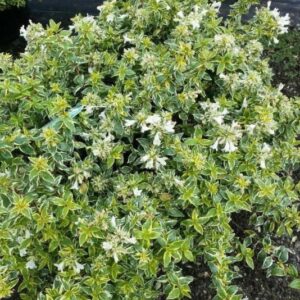
Try planting ‘Radiance’ Abelia
‘Radiance’ Abelia is prized for the year-round beauty of its variegated evergreen foliage. The fragrant blooms persist from spring to summer and are a favorite of both people and pollinators. This compact shrub also has incredibly low maintenance requirements, and is adaptable to various growing conditions. * for a native option look into white blooming Autumn sage or variegated Turk’s cap if you can get a hold of it!
Bonus Shrubs:
Texas Native Hollies:
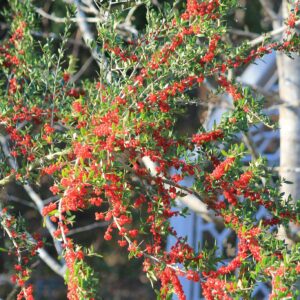
Standard Yaupon Holly (Ilex vomitoria) is a very popular native evergreen, that can both be categorized as a a small tree or a larger shrub—depending on the form you select. Female cultivar, ‘Pride of Houston’ grows roughly 15’ tall by 10’ wide wide bright red berries,– but newer male cultivars of the same species ‘Skyward’ (6’-8’ wide) and ‘Skyline’ (3’ wide) offer more narrow, upright forms.
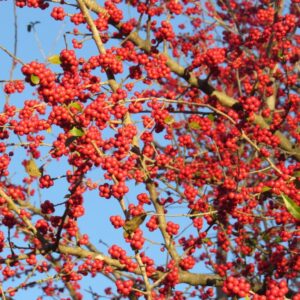
Possumhaw holly (Ilex decidua) is a native deciduous shrub that adds beauty to the landscape year-round. Its bright red berries provide winter interest, while its glossy green foliage is a welcomed sight in the spring and summer months. Best of all, it’s virtually maintenance-free once established.
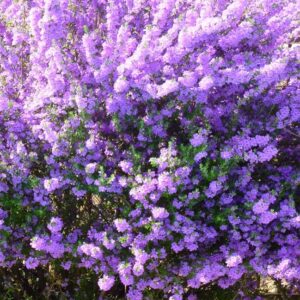
Texas Sage: (Leucophyllum spp)
For full sun, southwest facing, well-draining and/or sloped landscape areas, Texas Sage is often the toughest choice. While many are native to the state of Texas, others are indigenous to the extremely hot and dry regions of Mexico and Arizona. The genus Leucophyllum includes shrubs ranging from 3.5’-8’ tall (and wide), most having the iconic gray-green foliage in addition to cultivars with greener tones. Flower color ranges from white to pink, and lavender to blue—with most producing blooms most heavily after summer drought brings a substantial rainfall event, although some cultivars offer more frequent/reliable blooms!
Compact Carolina Cherry Laurel (Prunus Caroliniana ‘Compacta’)
Compact cherry laurel is a smaller “tamed’ version of a tough, Texas native evergreen shrub that thrives in a variety of conditions, including the heat and alkaline soils of North Texas. Its glossy foliage and dense growth habit make it an excellent choice for hedges, screens, or specimen plantings. It’s flowers and fruit are also a favorite of native pollinators and birds!
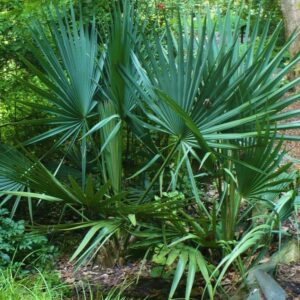
Dwarf Palmetto: (Sabal minor)
This dwarf palm (4’-6’) is a great native evergreen for both sun and shady spots, and although it thrives in wetter areas– it is also extremely heat and drought tolerant. Though not a traditional shrub, it can be used similarly as a resilient option to add year-round interest with it’s broad foliage and unique form. Its sweet smelling (abeit tiny) yellow blooms are a bonus– as are the small purple fruits that benefit songbirds and other wildlife.
By choosing Texas natives or Texas Tough adapted shrubs for your landscape, you can create a beautiful and resilient outdoor environment that thrives despite the challenges of our North Texas climate and soils. Plus, you’ll help support local ecosystems and reduce the need for water, pesticides, and other inputs, making it a win-win for both you and the environment. So why not make the switch today and start enjoying all the benefits that these fantastic shrubs have to offer?
Visit our retail nursery to learn more and let our horticulturists help you select the right plants for the right spot in your landscape!
Open Tuesday through Saturday 9:00-5:00, Sunday 10:00-5:00
12804 Pelzel Rd. Pilot Point Texas, 76258
